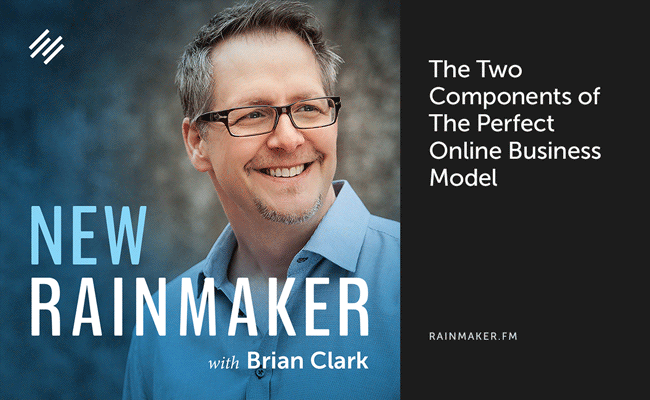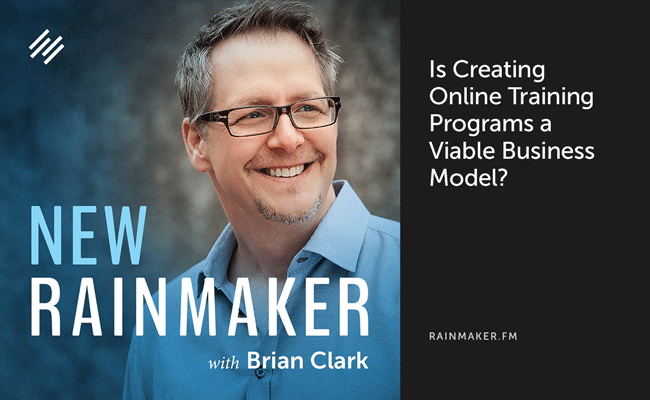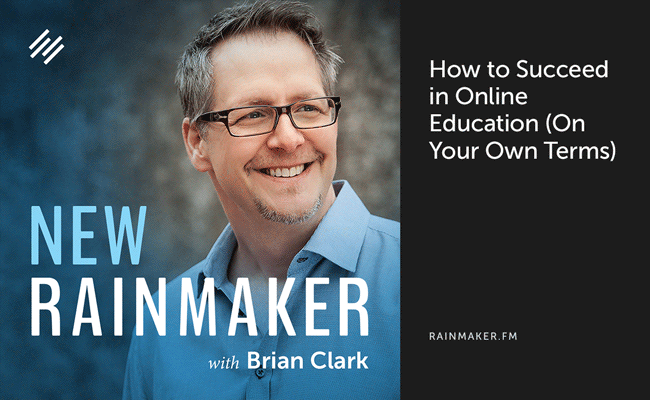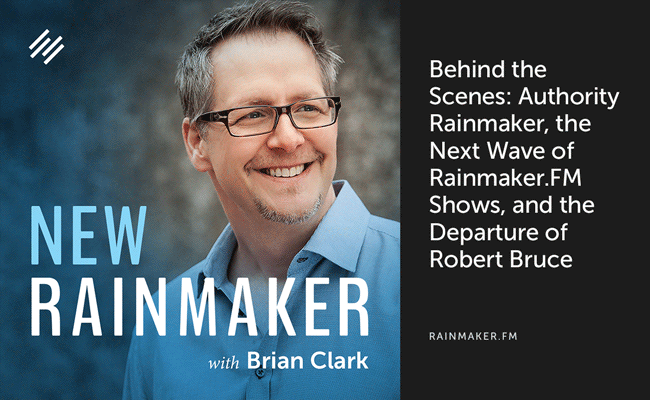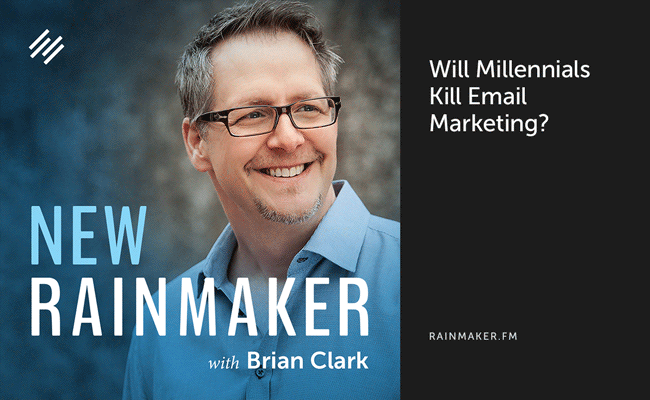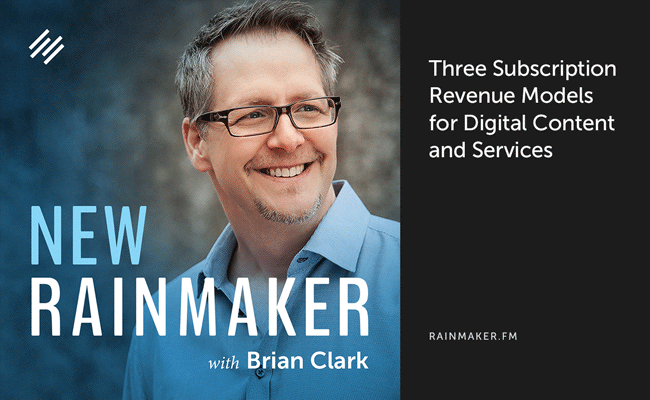
Digital + Recurring Revenue = Win. Easier said than done, right?
As we discussed last week, digital products and services plus subscription revenue are The Two Components of The Perfect Online Business Model. Let’s talk a little more about the subscription side of things.
This week, author and entrepreneur John Warrillow joins me as co-host, and we’ve got three models for you to contemplate when piecing together your perfect business. John is the author of The Automatic Customer: Creating a Subscription Business in Any Industry, and the founder of two recurring revenue businesses.
In this 32-minute episode John and I discuss:
- The only business model investors want to talk about
- How to start a bidding war for your business
- The priceless value of online recurring revenue
- How to make a membership subscription model work
- What the Netflix model can do for your business
- The growth power of the network subscription model
- The psychology of selling a recurring subscription
- How to overcome subscription credit card fatigue”
- Copywriting tips for selling recurring subscriptions
Listen to The Digital Entrepreneur below …
The Show Notes
- The Value Builder System
- The Automatic Customer
- Built to Sell
- John Warrillow on Twitter
- Brian Clark on Twitter
The Transcript
Three Subscription Revenue Models for Digital Content and Services
Brian Clark: This is Rainmaker.FM, the digital marketing podcast network. It’s built on the Rainmaker Platform, which empowers you to build your own digital marketing and sales platform. Start your free 14-day trial at RainmakerPlatform.com.
Brian Clark: Hey, everyone, and welcome to another episode of New Rainmaker. I am Brian Clark, your host and the founder and CEO of Copyblogger Media.
We have a really cool episode today because I have a really cool co-host, as has been our practice lately. Instead of having to listen to me ramble on monologue-style, we get smart people to join us and talk about smart things.
Today, we’re talking about subscription revenue models. Last week, we kind of set the stage for the perfect online business model, which would be a combination of recurring revenue and digital products and services. We’re going to continue on that theme today with a guy who wrote the book on the topic of the power of subscription models in general.
Today, we’re going to focus on three models in the digital realm that are extremely powerful for any entrepreneur or business person looking to create a recurring revenue stream. Today’s guest is John Warrillow. He is the author of The Automatic Customer: Creating a Subscription Business in Any Industry.
John, thanks so much for joining me today.
John Warrillow: Thanks for having me, Brian. It’s a pleasure to be here.
Brian Clark: Yeah, absolutely. I know you currently run a successful subscription-based business, and I know that you had one prior to that, which is pretty good credibility, I would guess, for the book that you wrote. Tell us a little bit about how you got started as an entrepreneur, and take us through to how we got here to today.
The Only Business Model Investors Want to Talk About
John Warrillow: Yeah, sure. I used to run a subscription business. I sold it to a Fortune 500 company in 2008. I wrote a book called Built to Sell back in 2011, and the idea was, how do you structure a business and make it more sellable? One of the themes in the book was the importance of recurring revenue as it drives up the value of your business. With this book, I really wanted to do a deep dive into that idea of recurring revenue and how important it is to the overall value of your company.
Brian Clark: We talked last week. I had either the privilege or misfortune of having two months of conversation with private equity investors. It’s gotten to the point where all they want to hear about is recurring revenue. That, to me, is a remarkable shift given that most of the world still operates on a transactional basis.
The Priceless Value of Online Recurring Revenue
John Warrillow: Let me give you an example because my day job, what you mentioned, my current business, is called The Value Builder System, where we estimate and help business owners improve the value of their company. It’s a subscription business, but we have now 14,000 users that have gone through and filled out our questionnaire.
What we see is that the average business on that questionnaire gets an offer that’s around one times top-line revenue, but if you’ve got recurring revenue, you can get as much as six times top-line revenue. It’s a huge impact on the value of your business. Why? Because acquirers want to know, “Well, what’s this business going to do once the owner hits the beach?” They want to know that the revenue’s going to continue to go on.
How to Start a Bidding War for Your Business
Brian Clark: Yeah, absolutely. Of course, we’ve seen scenarios where that gets up to 10X revenue, which is amazing. If it’s the right company in the right market with recurring revenue, you can get into a strategic acquisition bidding war if you have more than one suitor, which of course is ideal. Still, five to six times revenue compared to one or two — huge difference in the capacity of that beach house that you end up in.
John Warrillow: The size and square footage, exactly.
Brian Clark: All right, as promised, I want to talk about a few different models here. We’re speaking specifically about digital products and services and with the advent of things like Netflix and other recurring models, based on purely, now, digital distribution. Of course, Netflix, at one point, did ship — or I guess they still do, but who does that anymore? — the actual DVDs, which was a smart play. They were in it for the long term, but I recall an interview with their CEO that says if you look at the brand itself of Netflix, it was always going to end up pure digital.
John Warrillow: It’s a very good point. The logistics of managing shipping stuff in a subscription business, you just have to ask the guys at Dollar Shave Club how difficult that is to actually ship a physical product on subscription. So they’re moving in the right direction making it digital.
Brian Clark: Now, I know one of your other models — and we joked around about it last week — not that it’s not amazing and viable, but the stuff in a box thing, I find this amazing that you have all these businesses popping up serving relatively affluent people with everything from a collection of cosmetics to an outfit for a guy.
John Warrillow: Right, yeah. BarkBox is one of my favorite. This is the one for dog parents where they send the dog parent — the dog owner, but they call them parents — a collection of dog treats. What’s really interesting about those models, Brian, is that the key to making them work is less the subscription and more the sales on the back of the subscription.
At Birchbox, as an example — $10 a month and you get a box full of cosmetic samples, mostly women who subscribe — half of their subscribers have now bought a full-size version on their website. The real opportunity that a lot of people are chasing is the back-end sales on the website, on the back of the subscription. The subscription in and of itself is a bit of a Trojan horse.
Brian Clark: Yeah, and that’s something we’ve been preaching forever, whether you call it a gateway product or acquiring a customer. It’s the continued sales, whether in a recurring model or on a one-off transactional model, but yeah, I did note that about Birchbox. I thought it was brilliant. It’s old-school direct marketing, but brought forward into the digital — the world we live in today where you have to be much more trustworthy and transparent in our marketing. Yet it’s still the same principle. When you acquire a customer and you take care of them, you’re going to get the opportunity for more revenue.
John Warrillow: Absolutely, yeah.
Brian Clark: Okay, so let’s talk about our first model today. This one is the first one that pops into many people’s minds when they think of the combination of digital and recurring revenue. That’s the tried-and-true membership website model, probably pioneered by people in the porn industry in the ’90s, but much more legitimate these days.
Why don’t you walk us through the model in your mind and, also, if you’ve got some off-kilter examples. Everyone knows that training people in marketing and these very meta business models are using the membership model, but there’s really just a broad range of people who are benefiting from the model.
How to Make a Membership Subscription Model Work
John Warrillow: You bet. To define it, the membership model is where you take your expertise, what you know better than 99.9 percent of the world, and put it behind a pay wall and charge people a subscription fee to access that.
A couple of good examples that are a little bit out of the ordinary would be DanceStudioOwner.com. If you own a dance studio, they’ll give you the templates and tools and insight on how to make that a profitable business. They were acquired recently by Revolution Dance, who are one of the fastest growing dance apparel companies, because it was a gateway product for revolution. That’s one example.
Another good example would be Mark over at The Wood Whisperer. At The Wood Whisperer, they teach hobby woodworkers how to build cabinets — again, very deep passion for a lot of people — and Mark delivers a great membership website over there for them.
The key is that you’ve got to find something that people are passionate about. The best membership websites, the ones with the most longevity, are actually helping you make money. It’s like RestaurantOwner.com, how to run a successful restaurant. Joe Crisara at Contractor Selling is helping plumbers and electricians be better sales and marketing individuals.
The ones that are a bit harder to make go are the real consumer-like ‘everything you wanted to know about Italy.’ Maybe there aren’t enough people that are really passionate about that topic, but it’s very hard to get them to break out their wallet if they don’t see a direct line to revenue.
Brian Clark: Yeah, and I think you’ve made the point that the membership site model works when you’re solving real problems, which is usually in a business or financial context, more or less. Of course, in any market, it’s either passion or a true problem, let’s say weight loss. Of course, there are many programs that do really well there because that’s a serious problem. You can at least keep the customer until they reach their goals and maybe even maintain beyond that.
The other side of it, like the woodworking thing, is passion. It’s got to be intense. You want to master whatever it is. I think maybe that’s the ingredient that separates something that’s going to work with that model and something that’s probably not going to go over as well.
John Warrillow: Yeah, and the degree of complexity of what you’re teaching and also the visual nature of what you’re teaching. If what you’re teaching requires screen-grabs and video tutorials, and for people to get it, they got to see it — that’s the perfect circumstance for a membership website. Obviously, with membership websites, you can usually upload video and show people screen grabs. The higher degree of complexity, the more need they have for the information.
Brian Clark: Excellent point. Before we move on from this model, you touch on this in the book. This is something we’ve advocated since 2007 with our Teaching Sells program with online training specifically — multiple modalities of content in that you provide text, you provide audio, you provide video, or some sort of visual when it’s necessary to communicate the ideas, but more or less serving all the different learning styles.
John Warrillow: Absolutely. That’s very, very important in a membership website where you do have people that are better at watching, better at reading, et cetera, et cetera.
Brian Clark: It’s also odd — and we’ll talk about the psychology of selling these things in a little bit — but when you transform something, say, from text into video, all of a sudden people want to pay more money for it, which is odd, but it’s a truth.
Okay, the next one that I want to talk about is the all-you-can-eat library model. That’s an interesting descriptor, but doesn’t that describe what we opened with, with Netflix?
What the ‘Netflix’ Model Can Do for Your Business
John Warrillow: You bet. Basically, the all-you-can-eat library model is where you take your digital content and you put it in the Cloud. You put it behind a pay wall, and you say, “Here it is. It’s in a library format, search for it, and use it.” It’s evergreen information, while Netflix is always adding new content, the base of its database, its library is these thousands of titles they have access to and that you get access to in real-time. Netflix is the ultimate all you can eat.
You don’t have to be Netflix, though, to use this. There’s an example in the book about New Masters Academy, and they’re an interesting business. They help people learn how to acquire a new skill in art, so if you want to become a watercolor painter or a pottery maker, et cetera, you can subscribe to New Masters Academy. I think it’s $30 or $35 a month, and you get access to literally hundreds of tutorials on how to learn a new discipline in the world of art. It’s all you can eat because the library is up there, and you can pick and choose like a Chinese menu. People are buying access to more content than they could ever possibly consume.
Brian Clark: To give another example of something we’ve been talking about quite a bit lately since LinkedIn spent a billion and a half, Lynda.com is this model as well. Do you have any behind-the-scenes insight on Lynda? I’ve been tracking that site for a decade, but I never quite figured out what their model was for paying contributors.
John Warrillow: I don’t. At New Masters Academy, for example, their model for paying contributors is interesting. There’s a pool of revenue that goes in that basically gets split up between all the contributors, but most people do that on a number of usage basis. So the people who have popular programs are getting paid more in the payout model than those that have obscure ones.
With New Masters, what they were interested in was depth of content as opposed to really just three really popular things. They wanted to be able to have lots of content, so they pay out based on number of submissions, number of tutorials you, as an artist, upload.
That’s the key point about these models like Uber and Facebook. They don’t necessarily own the content. They’re providing, basically, a platform. At New Masters, they don’t hire or employ all the artists. They’re hiring artists that are teaching at community colleges and so forth today and saying, “Hey listen, let me come and record you for a day or two. We’ll build out the tutorial, and then we’ll do a revenue share on the back-end.” That’s how they’ve accumulated lots and lots of content very, very quickly. They’re not buying it. They’re doing rev-share deals.
Brian Clark: Nice, and I suspect Lynda did something similar. What we’re talking about here with this all-you-can-eat library is massive amounts of content really beyond feasibility for a single person to create or even to hire a bunch of employees or even freelancers to create.
Going back to Netflix, that’s obviously a licensing situation. Now, of course, Netflix has gotten into original content, which I think is brilliant, but they laid the groundwork with a vast library of licensing deals. Give us some insight on how the everyday entrepreneur can use licensing in this model.
John Warrillow: What you want to do is first pick a very small and niche where you can own it. Like Lynda.com and the rest, the big, broad categories I think are already taken. You want to pick a very small niche. As New Masters did, go find the thoughtful contributors in that space who don’t necessarily have the same depth of knowledge around digital assets.
What you, as an entrepreneur, listening to this program being part of the Copyblogger community, you’re obviously knowledgeable of that digital marketing, digital assets, and how to structure these. You can bring that talent to the table. Let those individuals who have a unique expertise, but not necessarily the knowledge to sell information products, to market.
Again, the structure of the deals is typically a revenue-sharing agreement where you put their content into an all-you-can-eat library. Then on the back-end, you share a portion of that revenue. Then depending on the philosophy of the site, you can share revenue based on number of downloads, number of views, or as New Masters did, based on number of assets or number of tutorials uploaded. Again, that gets back to what you’re trying to achieve with your all-you-can-eat library.
Brian Clark: Just some insight, in another approach, there are content producers out there — let’s say you want to create a membership site for freelancers and you want to provide legal forms, checklists, documents like that. We know there’s an entire market out there of sites that sell that type of product. But you can also find a supplier where you could do a licensing deal. That becomes part of your content, which is somewhat stock. Then you augment it with your original content, and you’ve got quite the lucrative offering. Keep that in mind. Licensing can be powerful as long as you make the economics of it work.
John Warrillow: Well-said.
Brian Clark: Let’s move on to the third. This one is fascinating, and it’s tricky. We’ve got some examples here of people who created subscription models with network effects that just made ridiculous amounts of money coming and going. I’ll let you talk about that one, but the network model, what is this?
The Growth Power of the Network Subscription Model
John Warrillow: Essentially, the network model is a subscription model where the defining characteristic is the more people subscribe in your market, the more powerful the subscription becomes for everybody. To get your head around this one, go back to when the telephone was first introduced in the 1800s. At the time, when you first launched the telephone, the only people who had a telephone were the sheriff, the doctor in town, and maybe the post office. The utility of a telephone was somewhat minimal.
As people started to buy telephones and you could call not only the sheriff, but you could also call your neighbor or your mom or your kid, it started to accelerate the benefit for everybody to a point where it grew like wildfire because the benefits, the best sales people became the users of the system.
A more modern day example of that might be World of Warcraft, the online video game series, where you can game individually, but it’s way more fun if you get your friends and contacts to game with you. There’s an acceleration or network effect that happens when the more people opt in, the better it is for everybody.
Brian Clark: Yeah, the fax machine is my favorite example. One fax machine is worthless, two is interesting, but two million is something. That’s exactly what happened until it got replaced by digital.
John Warrillow: My co-host, you’re sounding very old by saying that kind of stuff.
Brian Clark: Oh I know. Fax machine? What’s that?
John Warrillow: Exactly.
Brian Clark: You talked about the telephone.
John Warrillow: Right, exactly.
Brian Clark: I got this computer in my pocket that also makes calls, so I don’t …
John Warrillow: Touché.
Brian Clark: We think about network effects a lot these days in terms of free things that spread, such as, of course, Twitter, Facebook, same concept, but there’s no money being charged. Talk to me a little bit about WhatsApp, which went with a nominal subscription fee that added up to a whole lot of money and a gigantic acquisition.
John Warrillow: Yeah, WhatsApp is probably the poster child for this network model where, as you know, before they were acquired by Facebook, you could subscribe to WhatsApp, and after a year of using it for free, they charged you $1 per year subscription. You think, what on earth do they care about a dollar? Well, the dollar helped them create the platform that would actually get rid of all the cheesy ads that were on all the competitive messaging platforms who chose to monetize their platform by advertising.
The guys at WhatsApp said, “You know what, we’re going to create a clean app, no ads, but you got to pay $1 a year.” Well, they were, at the time of the acquisition, acquiring a million new users a day — a million new users a day. More pictures were being exchanged on WhatsApp than were on the entire Facebook platform, and as you know the story ends, Facebook acquires WhatsApp for I can’t remember the number off the top of my head.
Brian Clark: $19 billion.
John Warrillow: Yeah, I was going to say $18 or $19 billion dollars. At the time, WhatsApp had about 50 employees.
Brian Clark: That’s the size of my company. I’m feeling a little inadequate at the moment, but it’s amazing because 250 million $1 subscriptions, is still $250 million dollars. Did Facebook end up killing the dollar subscription?
John Warrillow: To my knowledge, they have. They certainly said that that was part of their intent at the time.
Brian Clark: That means the original deal — Facebook is great at this — is going to be killed because they’re going to pollute it with ads.
John Warrillow: Right. Yeah, it wouldn’t be surprising. I haven’t followed the latest implementation.
Brian Clark: I don’t use it, so I don’t know. Anyway, still a fascinating story. The network model is intriguing. I think it’s the trickiest of the three that we’re talking about, but it’s always fodder for creativity to start thinking about these models.
John Warrillow: That’s what we try to do in the book, Brian. I say this in the section. I lay out these nine models, and I say, “Do me one favor. As you read these, don’t put your feet up and say, or put your hands up and say, ‘This would never work in my industry.’”
My hope is that when people read them, it’s go with an open mind, and they’re saying, “Well, what could I steal from this guy in this industry and apply, be the first to apply it to my business or my industry.” I think with that open mind, you can steal ideas and be the first to innovate in a different industry.
Brian Clark: Absolutely. That works almost for any business model. I love the stories of how Henry Ford created the auto assembly line by visiting a Chicago meatpacking plant. It’s always what the other person is doing in a non-competitive industry that sparks the most creative and innovative ideas.
John Warrillow: I’d never heard that example. That’s great.
Brian Clark: Oh, it’s a great one. There’s another one about the printing press was actually inspired by the grape press for creating wine. It’s always the weirdest place. I always tell people, “Go, get outside of your little world, and you’ll get a better idea than just staying inside the box,” to use a cliché.
John Warrillow: Yeah, well-said.
Brian Clark: Few tips here. I don’t want to keep you too long, but I’m having a lot of fun because this is one of my favorite topics.
John Warrillow: That’s great.
The Psychology of Selling a Recurring Subscription
Brian Clark: ‘Psychology Is Selling a Subscription’ is an entire chapter in the book. You also have some very useful chapters in the book about the math that you have to do to make it viable, so obviously, people, pick up the book. It’s a bargain.
Let’s talk a little bit about this. I love how you open the chapter with, “Selling a recurring subscription is different than selling a stick of deodorant,” which I thought was the understatement of the year, if not the decade. Let’s talk a little bit about it.
What are the primary considerations that you have to take into account when you’re trying to get a person to say, “Yes, it’s not only worth it for me to open my wallet, but for me to be charged on a periodic basis.”
John Warrillow: Think of it as the difference between a one-night stand and a marriage. One-night stand, both consensual parties go off and have a good time for an evening. Neither party is committed to the other and both can go their separate ways at the end of it, whereas a marriage arguably has a lot bigger benefits, a bigger value proposition for both parties over the lifetime — but it takes a bigger commitment.
A subscription is akin to a marriage. You’ve got to build trust and make a case that you’re going to look out for that person’s best interests. Unfortunately, I think, we’re getting a bit of subscription fatigue setting into the market, where all of us look down our credit statements now — I don’t know about you, but when I look down my credit card statement, instead of seeing my two or three lumpy purchases, I see 50 $10-, $20-, $40-a-month charges now from Netflix, Salesforce.com, and all the other folks that we subscribe to in our business.
How to Overcome Subscription Credit Card Fatigue
John Warrillow: The credit card statement is causing a bit of subscription fatigue, which increases the need to overcome this fatigue. One of the strategies I talk about is the psychology of selling a subscription. One of the strategies people should think about is thinking 10X versus 10 percent. Nobody is going to subscribe to what you do by offering a 10 percent discount.
I was having this conversation with a dentist the other day. I was speaking, and a dentist come up to me and said, “Well, how does this work in dentistry? Could I have people subscribe to dental cleaning?” I was like, “Yeah, absolutely you could.” So he’s like, “Well, maybe I could give them 5 or 10 percent off.” I stopped him. I said, “Nobody’s going to subscribe for cleaning just to save 10 percent. What you’ve got to imagine is, ‘How do I make this value proposition 10 times better than just buying on a one-off basis?’”
At New Masters Academy we were talking about earlier, for $30 a month, you can get access to a library of content, which each one of those courses might be $600 or $800 at a community college. There’s a 10X value proposition. You get Netflix, you could make a really strong argument that Netflix is a 10X value proposition. For $10 a month, you’re getting access to hundreds of thousands of titles. So think 10X versus 10 percent.
Brian Clark: Yeah, and I think it also goes back — because you’re right — about credit card fatigue. Now, in my business, I don’t think twice about it because the value is evident. Can I do without this and still deliver the same experience? No, I can’t. Okay, it’s good.
On the consumer side, Spotify, Netflix, I’m an entertainment junkie when I have the time, so those are definitely worth it to me to have access to pretty much any song or any movie that I’m really looking for, but the more superfluous stuff is where people might get into danger with churn and things like that.
John Warrillow: You’re absolutely right. If you look at the churn rates of B2B software, business-to-business software, where it’s mission critical, and particularly industry-specific software, the churn rates are less than one percent a year. They’re infinitesimal, which drives the huge multiples you’re seeing for those industry-specific recurring revenue businesses.
Whereas, I think you’re absolutely right. Some of the more consumer-oriented, take it or leave, discretionary, those are the ones where you’re seeing lots of very high churn rates. Again, speaking to the importance of sticking, if you can, into a business-to-business model where you’re going to get lower natural churn rates.
Brian Clark: Yeah, absolutely. Okay, value, obviously. Any language or copy tips? We’ve got a lot of copywriting people who listen. They’ll be interested in what are some of the points that you really have to get across to get people to rationalize and improve the purchase. You start with the emotional response, and then you got to justify it logically.
Copywriting Tips for Selling Recurring Subscriptions
John Warrillow: Right. Like any good copywriting, you’ve definitely got to make both a very rational, but also an emotional connection. On the rational side, ironically, Microsoft’s doing a pretty good job with Office 365. One of the rational value propositions is, “Look, when you subscribe, unlike when you install a set of CDs on a computer, you’re instantly, the moment you install them, you’re susceptible to viruses. Unlike that situation, with our software, as a subscriber, you will get instant patches and instant downloads for virus protection.” That instantaneous value proposition is always on.
Words like ‘instant access’ and ‘always on,’ and those sorts of words that imply a real-time connection — ‘On-demand,’ ‘as you need it’ — are all words that connect for sure. The emotional side of it is painting the picture of what it means to be a subscriber.
At BarkBox, I mentioned them earlier, they’ve got two, last time I checked, full-time employees whose only job is to drop happiness bombs on their subscribers. A ‘happiness bomb’ is when they send a spontaneous gift to a subscriber who has had a bad situation. Usually, it’s a dog owner who’s had a dog who’s gotten sick, and so they send a spontaneous gift. Now, why would they hire two full-time people to do that? Because that breeds a sense of spontaneity and romance into the relationship, which is what drives the lower churn.
Brian Clark: That’s brilliant. I love it. In the post-Zappo’s world, delighting people is what you have to strive for, not just adequately keeping your promise. That’s a challenge. That’s a great example. I like the Microsoft example, too. We found, from our standpoint with the Rainmaker Platform compared to WordPress, the fact that we update, manage, security, all of that was more of a selling point than we originally thought at the beginning. You just have to look where the pain is and adequately communicate that.
John Warrillow: Absolutely.
Brian Clark: All right, people. I highly recommend The Automatic Customer. It’s very concrete, yet I consider it an idea generation book like John mentioned. “How do I take bits from here and bits from there and create something new?” It’s not creativity that comes from staring out the window. It’s from observing what others are doing and then seeing the connection with what you’re already doing.
John, I’d like to thank you for joining us today. If I might be so bold, I’d love to have you back as a co-host from time to time, if you’re interested.
John Warrillow: Yeah, I’d love to do that, Brian, any time.
Brian Clark: Awesome. All right, everyone, take care. We will be back next week with more. As always, if you can find the time to head over to iTunes and leave a rating and review for us, I would greatly appreciate it. It definitely helps.
In any event, I will be back next week with more. Take care, everyone.
